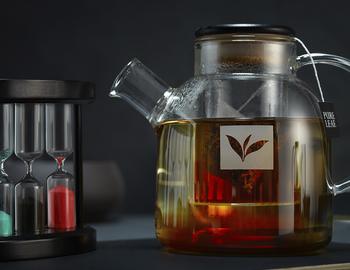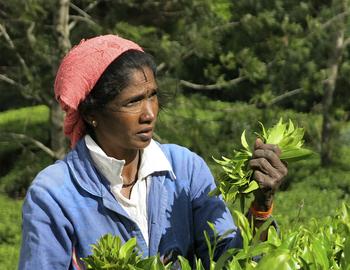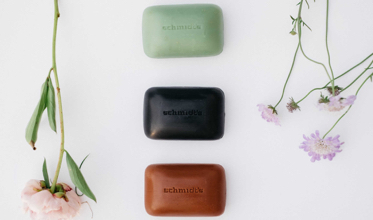Where Does Tea Come From?

The origin of tea is every bit as fascinating as the drink itself. While many people assume that green, white, black, pu-erh and oolong teas come from different plants, each type of tea begins as Camellia sinensis. The distinctions between these teas comes not from the type of plant, but rather from how the tea is prepared after the plant has been harvested.
Camellia sinensis: the tea plant
The process of harvesting the plant can have a significant impact on the resulting tea. Typically, Camellia sinensis is grown in special tea gardens. The best tea gardens are found in cooler climates, where the Camellia sinensis thrives; if left alone, this remarkable plant can grow to 30 feet tall. Tea growers keep their gardens cut back to improve the taste of the tea and make the harvesting process easier. During the harvest season, the finest teas are hand-picked by tea experts who know how to choose the best tea leaves. For finer teas, this means sticking exclusively to the two uppermost tea leaves, along with leaf buds located at the tips of the stems.
How your favorite teas are made
Immediately following a tea harvest is the withering process when tea leaves are set out to dry. Once the moisture has been removed from the tea leaves, they are then rolled and fermented. The fermentation process is important in that it produces the essential oils that give teas their distinctive aromas and flavors. When fermentation is complete, tea leaves are sorted out by size. Most teas include a combination of full leaves, smaller leaf pieces and tea dust. This unique combination gives more character to each batch.
Although oolong, white, black and green tea is all made from the same plant, herbal teas have a different background. Unlike the teas described above, herbal teas typically don’t come from tea leaves. Instead, they’re most commonly made from seeds, berries, flowers or roots. Herbal teas can be created from a variety of plants, including (but not limited to) chamomile, peppermint, dandelions, hibiscus, barley, sage and rosemary.
The wonderful thing about tea is that no matter which type you prefer, you can always discover a unique experience when you brew a cup. Tea drinkers have enjoyed the relaxing aura surrounding this popular beverage for millennia and, based on the recent resurgence of tea, that tradition is not likely to die out anytime soon.
References:
- #1. Duffy SJ, Keaney JF Jr, Holbrook M,et al. Short- and long-term black tea consumption reverses endothelial dysfunction in patients with coronary artery disease. Circulation. 2001;104:151-156.
- #2. Grassi D, Mulder TP, Draijer R, Desideri G, Molhuizen HO, Ferri C. Black tea consumption dose-dependently improves flow-mediated dilation in healthy males. J Hypertens. 2009;27:774-781.
- #3. Jochmann, N.; Lorenz, M.; van Krosigk, A, et al. The efficacy of black tea in ameliorating endothelial function is equivalent to that of green tea. British Journal of Nutrition. 2007.
- #4. Hodgson JM. Effects of tea and tea flavonoids on endothelial function and blood pressure: a brief review. Clin Exp Pharmacol Physiol. 2006; 33: 838-841
- #5. Arab L, Liu W, Elashoff D. Green and black tea consumption and risk of stroke: a meta-analysis. Stroke. 2009;40:1786-1792.
- #6. Eating Well with Canada's Food Guide, 2007.
- #7. Gardner EJ, Ruxton, CHS, Leeds, AR. Review. Black tea - helpful or harmful? A review of the evidence. Eur J Clin Nutr. 2007; 61:3-18.
- #8. Popkin BM, Armstrong LE, Bray GM, Caballero B, Frei B, Willett WC. A new proposed guidance system for beverage consumption in the United States. Am J Clin Nutr. 2006;83:529-542.
- #9. Dietary Reference Intakes for Water, Potassium, Sodium, Chloride and Sulfate. National Academy of Sciences, Institute of Medicine, Food and Nutrition Board; 2004:5-6.
- #10. Maughan RJ, Griffin J. Caffeine ingestion and fluid balance: a review. Journal of Human Nutrition and Dietetics. 2003;16:411-420.
- #11. Hindmarch I, Quinlan PT, Moore KL, Parkin C. The effects of black tea and other beverages on aspects of cognition and psychomotor performance. Psychopharmacol. 1998;139:230-238.
- #12. Hindmarch I, Rigney U, Stanley N, Quinlan P, Rycroft J, Lane J. (2000) A naturalistic investigation of the effects of day-long consumption of tea, coffee and water on alertness, sleep onset and sleep quality. Psychopharmacol. 2000;149:203-216.







